- Staffing
- Design New
The need for human connection is a biological and social imperative; loneliness is a warning signal to satisfy that need by seeking out other human beings.
- Fostering Interaction
- Engaging Participants
- Marketing
Building Relationships
SECTION 7
It is the relationship–what is happening between generations–that really matters. Intergenerational activities and programs are a means to building a culture of caring relationships.
– Saez, Ponazo, and Sanchez (2007, pg.186)
Meaningful intergenerational engagement is at the core of high-quality intergenerational facilities. Beyond providing services, shared sites intentionally foster personal bonds and feelings of affection, support, trust, and companionship. Relationships become an end in themselves as people of different ages engage in shared experiences. This focus on being together with people of different generations in a safe, caring place can foster empathy, mutual learning, and a sense of connectedness.
Although physical proximity can increase the likelihood that children and older adults will interact, it does not guarantee that meaningful relationships will form. The age and ability level of participants, physical space, the nature of programming, and cultural norms and values will impact relationship development. It is important to prepare both children and older adults to engage in new relationships, to treat each other with respect, and to acknowledge commonalities and differences. Think about how you can create BOTH structured activities that intentionally promote authentic cross-age exchange AND opportunities for informal interaction.
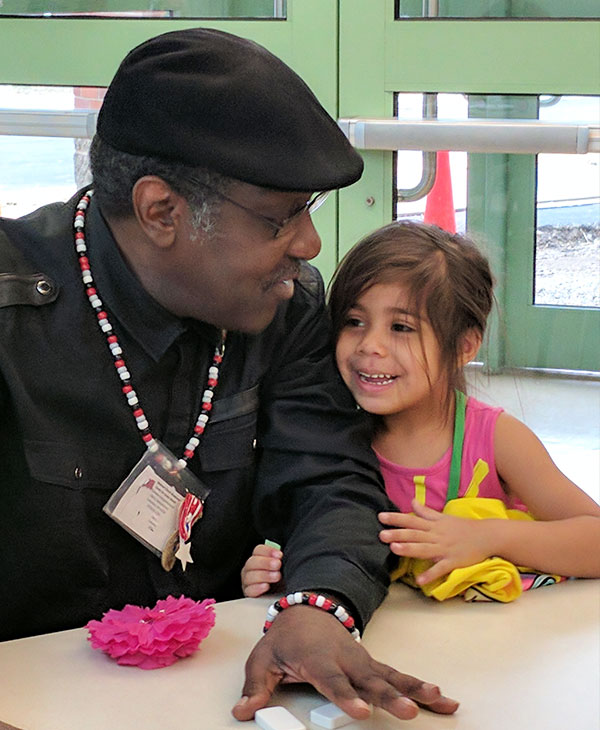
7.1 Designing Structured Activities
7.2 Range of Activities
7.3 Logistics
7.4 Engaging Participants
7.5 Preparing Older Adults to Work with Young Children
7.6 Sensitizing Young Children to Aging Issues and Older Adults
7.7 Fostering Informal Intergenerational Interaction
7.8 Engaging Family Members and Community Volunteers
7.9 Additional Resources
7.1 Designing Structured Activities
A wide range of activities and programs can be developed for participants in your shared site. It is important to align programming with your mission, values, physical space, and policies as well as the needs and interests of the populations you serve. The type of activity and the way it is facilitated will greatly impact the level of intergenerational engagement. Staff members who are trained in intergenerational best practices, work as a team, and have a good understanding of participants can play a critical role in the creation of a high-quality shared site. (See STAFFING section of Toolkit).
Characteristics of High-Quality Intergenerational Activities
- Person-centered and asset-based
- Focused on interaction (being with) and the process of building intergenerational relationships instead of on the activity (doing) as an end itself
- Flexible and able to be adapted
- Space-smart (e.g., taking maximum advantage of space as an asset)
- Conducive to spontaneous interaction
- Not an isolated effort but part of a longer process connecting multiple activities
- Driven by the interests of participants
- Jointly planned by staff of children’s and adult programs
- Voluntary
- Developmentally, physically, and culturally appropriate for both children and elders
Remember to focus on process over product! Positive interaction between age groups is more important than the successful completion of an activity.
Strategies for Designing Activities
Identify the interests, strengths, and needs of participants.
It is important to know the backgrounds and interests of the children and older adults with whom you are working in order to design activities that will engage participants. You can gather this information through individual interviews, surveys, focus groups, discussions with parents or caregivers, and/or experiential exercises. It is particularly helpful for staff to elicit stories and background information from elders with cognitive impairments and/or their caregivers so that they can draw upon it when planning or conducting activities.
Questions for older adults:
- What are your skills, job or travel experiences, talents, or passions?
- What do you think you could share with or teach children?
- What would you be interested in learning about or learning to do?
- What activities would you enjoy doing with young people? (e.g., reading books together, cooking, gardening, storytelling, movement, games).
- What kinds of things did you enjoy doing as a child?
- How do you feel about interacting with children on a regular basis?
Questions for children:
- What kinds of things do you like to do?
- What are you good at?
- What would you like to learn about?
- What could you teach older people?
- What questions do you have about older people?
- Do you know any older people? If yes, how would you describe them?
EXAMPLE: Experiential Exercise
Here is an example of an exercise that focuses on the “gifts” people can share. It is an effective way of learning about the assets of older adults and could be used with children who are old enough to understand these concepts.
HEAD, HANDS, AND HEART
Begin the activity by explaining that everyone can bring special gifts to any group. You can either create a handout or just discuss the following “gifts.”
Gifts of the hands: What talents or skills do you have that you could share with others (e.g., woodworking, singing, dancing, painting, cooking, sewing, gardening)?
Gifts of the head: What specific knowledge do you have that you would like to share with others (e.g., art history, a foreign language, event planning)?
Gifts of the heart: What special social or emotional gifts do you have that could help you work with children (e.g., empathy, friendliness, patience, sense of humor, good listening skills)?
Clarify your objectives for each activity.
Intergenerational activities can result in a wide range of educational, developmental, and socioemotional mutual benefits. Be clear about what you want to achieve and the process you will use to reach those objectives. Consider two types of objectives – one focused on individual change (e.g., improvement of social skills in a child) and the other focused on group change (e.g., promote intergenerational friendship among participants from different generations).
Take a look at a list of objectives for activities involving frail elders and preschoolers from Generations United’s Tried and True: A Guide to Successful Intergenerational Activities at Shared Site Programs.
Engage participants in planning activities.
Research suggests that engaging participants in planning activities can increase engagement and contribute to self-esteem. This applies to older adults who often experience a loss of power as well as children who often just follow instructions from teachers. Using an “empowerment” framework when designing activities involves:
- Sharing responsibility for making program-related decisions
- Asking people for their opinions and ideas routinely
- Involving participants in roles such as “peer recruiters” or “intergenerational ambassadors” and creating ways to incentivize them
- Developing an evaluation that provides opportunities for participants to share their views on their own terms (e.g., through focus groups, interviews, journals)
Click here to read an article about empowerment.
Design activities that take into consideration the ages, abilities, and cultural values of the populations you are serving.
“It is important to value the individual abilities that children and older adults are building or trying to maintain as well as the social histories and cultural identities that shape their identities.”
— Shannon Jarrott
It can be challenging to design activities that provide developmentally and functionally appropriate learning experiences for children and older adults. Since there is often wide variability in functional levels within these groups, it is important to offer a continuum of activities that reflect different abilities and interests and require different levels of energy. Activities should have a meaningful purpose that is significant and relevant to all participants. The following are some of the skills or tasks that are important to people at different stages of life.
Developmental tasks of early childhood: Crucial developmental tasks during the first five years of life center on the mastery of essential building blocks for later success in school. These include the ability to get along with others, make friends, become engaged in social groups, and begin to manage powerful emotions. Intergenerational programs can provide meaningful socialization and learning opportunities for young children and provide a solid foundation for further growth.
Developmental tasks of old age: There are many different frameworks for understanding the developmental tasks of old age. Critical issues older adults must address include the loss of previous roles (e.g., work, raising a family), changes in physical and cognitive abilities, and their own mortality. If thoughtfully designed, intergenerational activities can help enhance elders’ well-being by offering them new roles, expanding the range of activities in which they are engaged, and providing them opportunities to transmit their knowledge and experience to future generations.
Tips!
- Be careful not to create activities that infantilize older adults. Choice, mutual interaction, adult status, and opportunities for elders to teach or mentor are important elements of age-appropriate programming.
- Consider ways to modify an activity for participants who have significant physical limitations. Using adaptive equipment such as appropriately-sized scissors and paintbrushes can promote engagement and support feelings of self-sufficiency.
- Practice doing an activity with an older adult who has significant limitations BEFORE they engage with a child. This can build self-confidence and a sense of ability.
- Role-play scenarios ahead of time with children in order to increase their confidence and understanding.
- Make sure that all participants understand what the activity is about. Before getting started repeat the purpose of the activity and invite participants to ask questions about it.
CULTURALLY SENSITIVE PROGRAMMING
Understanding the role culture can play in promoting meaningful relationships is critical for successful programming. Be aware of differences regarding cultural norms, values, and communication patterns. In some cultures, older adults expect young people to listen more than talk and not to question an authority figure. Different cultures may have different norms related to eye contact, touching while talking, personal space, and topics that are inappropriate to discuss with a stranger. Explicitly address the fact that cultural differences add richness to a program.
Take into consideration your physical space.
The size, layout, and location of your space will influence the types of activities you design. Do as much as possible to make the space an ingredient for enhancing the power of intergenerational interactions.
If possible, use a variety of indoor and outdoor spaces for activities. It is also important to prepare your space – minimize safety hazards, minimize distractions, and lay out materials beforehand. When possible, provide sets of materials that children and older adults can share rather than giving participants each their own supplies.
Develop a coordinated intergenerational curriculum rather than a series of discrete activities.
This can include ongoing activities (e.g., reading, exercise) as well as programs focused on specific themes such as the life cycle, your neighborhood, or Black history. Programs can extend across multiple sessions, with participants gathering and preparing materials, creating a project, and sharing it with others.
Tips!
- Do some research to find evidence-based intergenerational programs that have theoretical underpinnings.
- Start with activities that are easy to manage, fun, and will most likely be considered successful by participants and staff.
- Engage participants in making re-usable name tags. Many older adults can read even if they can’t remember a child’s name from one session to the next.
- Encourage older adults and children to let go and have fun. Laughing and engaging in silly activities can break down barriers and promote connection.
- Make sure you don’t over-facilitate activities. Children and older adults should have a sense of ownership in the process.
- Involve everybody in any possible way, including stakeholders such as family relatives and community actors.
- Don’t just trust your own intuition but try to implement an evidence-informed approach (based on a combination of expertise from practice, research, and lived experience).
Download a Word version of the intergenerational activity plan worksheet adapted from Generations United’s Tried and True: A Guide to Successful Intergenerational Activities at Shared Site Programs.
7.2 Range of Activities
There are many activities that can help you meet your stated goals and objectives. These can vary in terms of focus, intensity, duration, and structure. Activities should have a beginning (ice-breaker), middle (actual activity), and end (reflection).
Ice-Breakers
Ice-breakers are quick (5-10 minutes) experiential exercises that help people of different ages feel comfortable with one another. Here are a few examples that highlight commonalities and differences between age groups. These should be adapted based on the cognitive and verbal abilities of your participants.
Round up:
Ask the group to stand or sit in one large circle. The facilitator stands in the middle and announces a category such as:
- Likes chocolate
- Loves to read
- Is afraid of the dark
- Has a brother or sister
- Likes to dance
Ask all those who think they fit a category to raise their hands. Ask everyone to look around to see who is like them. Continue picking categories until everyone has raised their hand. End with a discussion about differences and commonalities between age groups.
Me Too:
Start with the whole group seated. Ask one person to make a true statement about themself such as “I love ice cream,” “I live with my grandmother,” or “I don’t like string beans.” Ask those who feel that statement applies to them to raise their hands and shout “Me too.”
Lead a discussion about what group members have in common and what sets them apart.
Sample Activities
Family-style/Nurturing Activities:
Typically, both children and older adults enjoy engaging in conversations, reading together, cooking, and storytelling. Many elders also enjoy rocking and feeding babies and/or helping children with lunch or naptime.
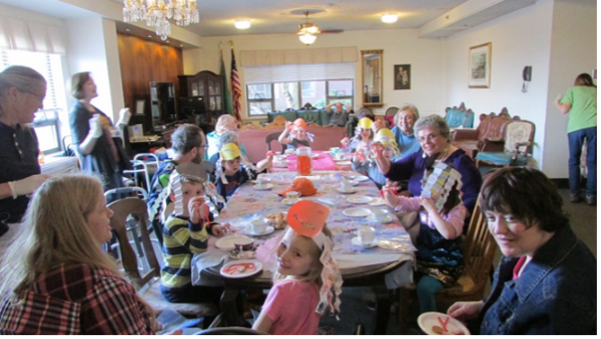
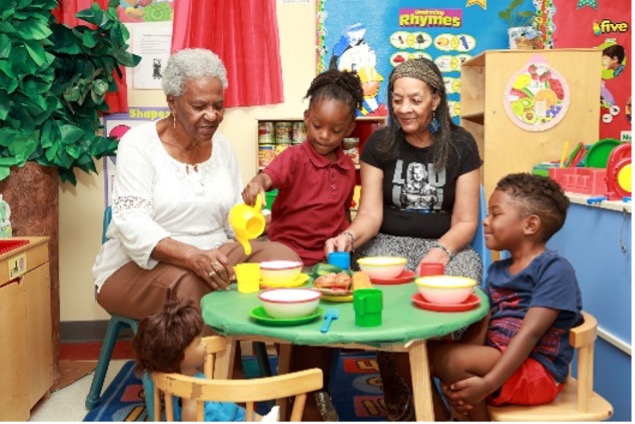
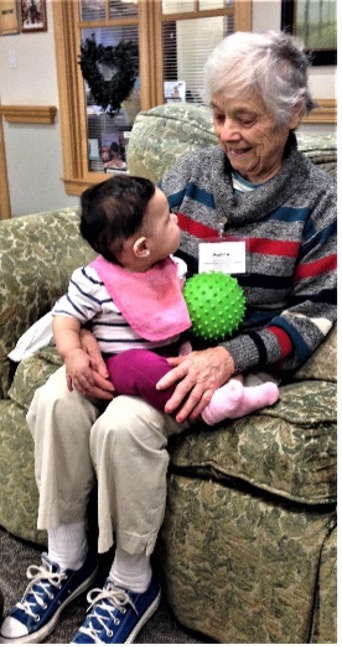
Educational Activities:
Some older adults can help children learn literacy and numerical skills by reading stories, listening to children practice reading, or engaging in interactive math games.
“It’s such a good feeling to just listen, read along, and help with words.”
— Older adult
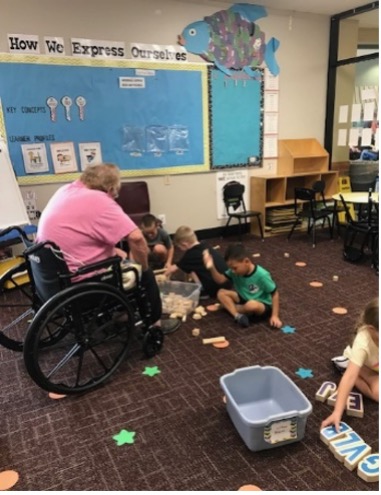
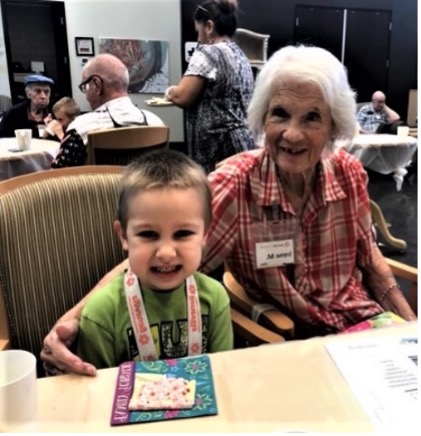
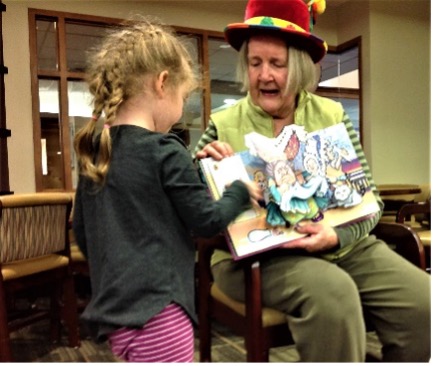
Sensory:
Activities that engage the five senses and are tactile in nature are popular. Try making play-dough, making a fruit salad, or creating different sounds.
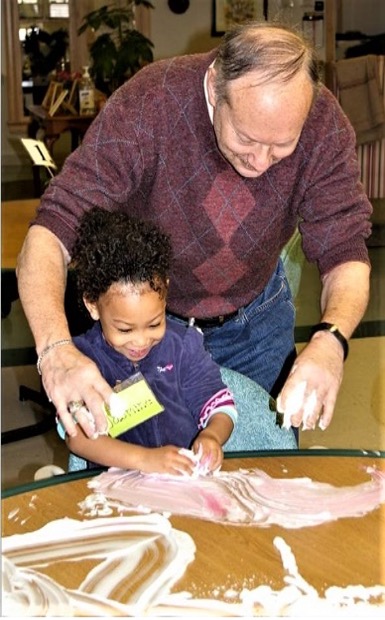
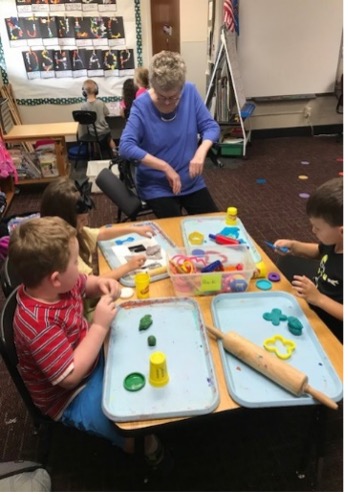
Celebratory:
Bringing children and older adults together for birthday parties, holiday celebrations, parades, and special cultural events creates opportunities for fun and learning.
“All of our programming is focused on building relationships between our children and our older adults.”
— Marie Hoover, Providence Mount St. Vincent
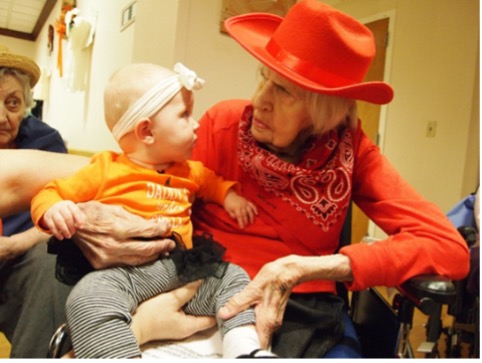
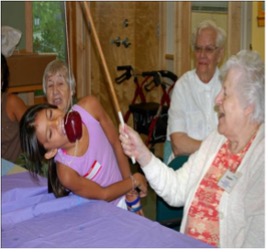
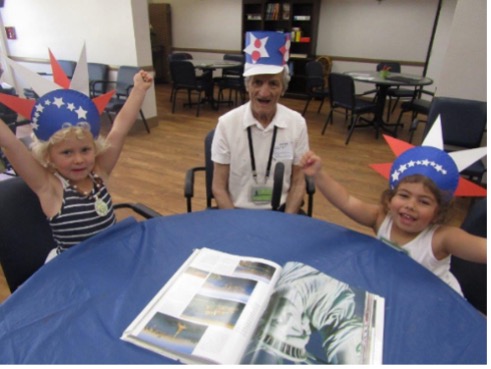
Arts:
The arts are a wonderful way to foster cross-age interaction. Children and older adults can make joint collages, sculptures, and paintings; engage in role-playing and drama activities; and/or make music together.
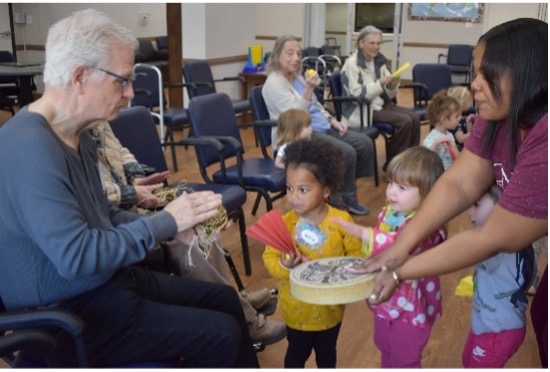
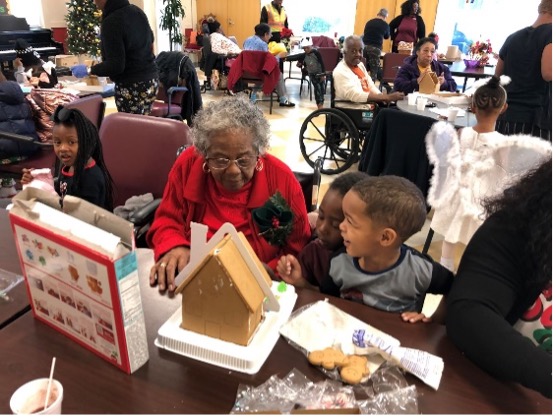
Movement:
Activities like physical fitness exercises, walking, dancing, and even an Intergenerational Olympics can improve the health and well-being of both children and older adults.
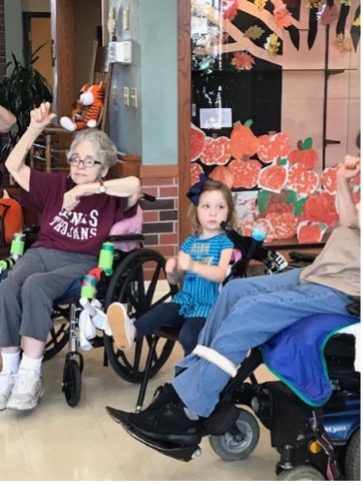
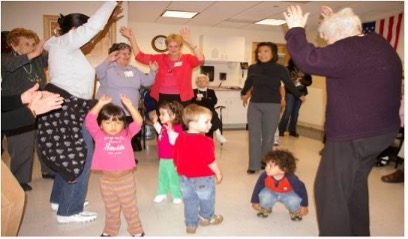
Healthy Living:
There are many health-related activities that are appropriate for young and old participants. Try creating an indoor garden to plant herbs, root vegetables, and salad greens. Older adults could teach children about the importance of healthy eating habits and including vegetables in their daily diet.
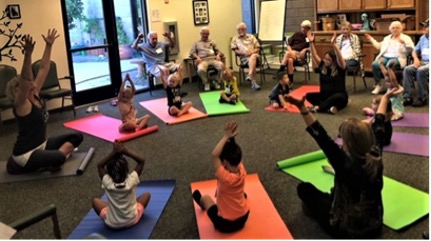
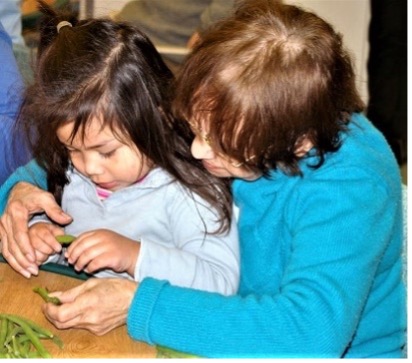
Fun and Games:
Less structured activities like ball throwing, ring toss, or peek-a-boo under a tarp promote high levels of spontaneity and support children’s need to move!
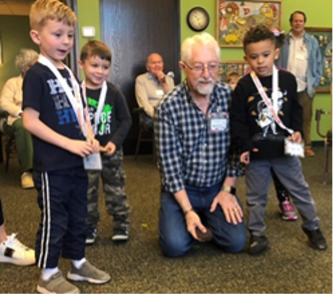
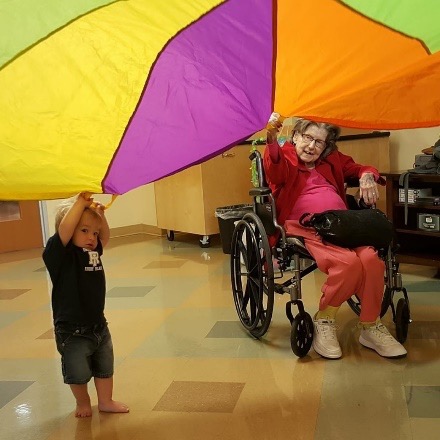
Cultural Traditions:
In many places, intergenerational activities are focused on the transmission of cultural values, tradition, and knowledge. These activities can reinforce and celebrate a shared sense of cultural identity and pride.
Outdoors:
Intergenerational gardening, picnics, fishing, and outdoor sports help children and older adults learn about and enjoy the natural environment.
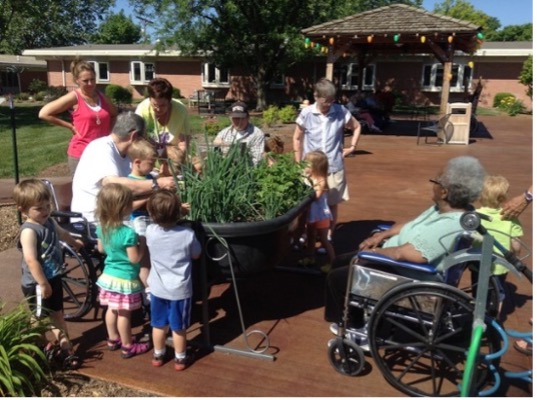
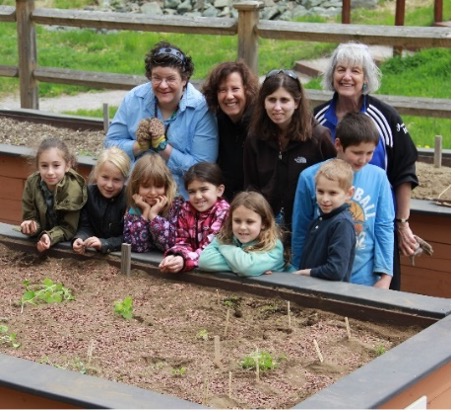
Virtual Connections:
When in-person cross-age interaction is not possible, many shared sites have found creative ways to virtually connect age groups via Zoom, Google Meets, or other online platforms. It is important to be aware of participants’ comfort levels using technology, access to technological devices, and level of digital literacy. Here are some ideas for you to consider:
- Have staff take videos or slides of children and upload them to a closed-circuit TV that can be watched by older adults.
- Start a pen-pal program between children and older adults. This could involve sharing drawings if children are just learning to read and write.
- Put a plexiglass partition up between programs and encourage participants to play games like tic-tac-toe.
- Organize socially-distanced events such as musical or dance performances in large outdoor areas.
- Ask children to make greeting cards for older adults. Include photos of the children in the cards.
- Organize drive-thru events at which children and older adults wave to each other and display creative signs.
- Set up Zoom meetings between small groups of older adults and children. These could include a virtual show-and-tell or simple games to engage participants.
- Record older adults reading stories that can be used in the child-care classrooms.
- Use an iPad to show babies playing or doing an activity. Residents often start reminiscing during these visits.
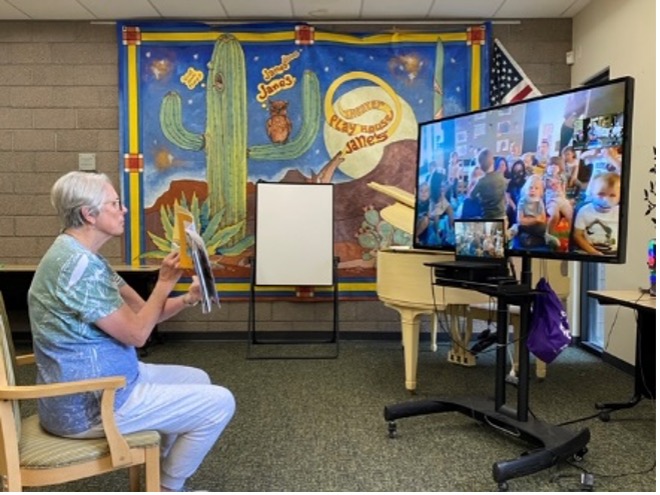
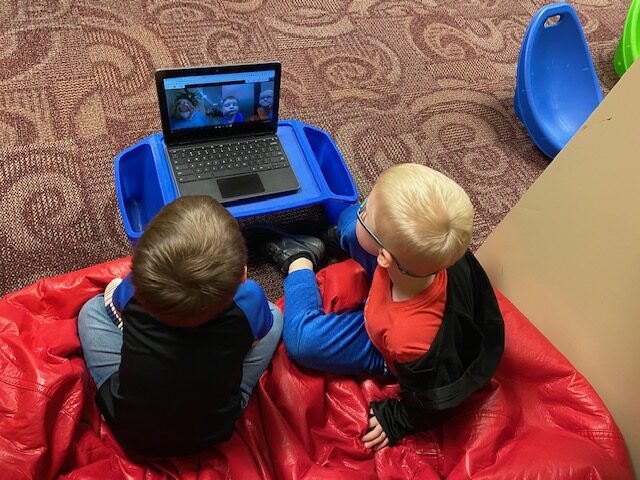
Tips!
- Try offering activities that require both children and older adults to learn something new. This puts participants on equal footing and removes pressure for older adults to demonstrate their ability to do a task.
- In long-term care facilities, ask children to knock on the doors of people who are hesitant to join intergenerational activities. This personal outreach can help older people feel more comfortable joining group activities.
- Be cautious with the duration of activities. Typically, shorter activities that leave participants eager for the next encounter work better.
Reflection
At the end of each activity, it is helpful to ask children and older adults to reflect on what they have learned. Their feedback will help you redesign activities for the future and build ownership in the program. These questions should be adapted based on the abilities of your children and older adults.
Possible questions to ask include:
- What did you enjoy about today’s activity?
- What did you learn?
- Did anything surprise you?
- Is there anything you would do differently?
You can also reflect separately later with the children and older adults. You might ask:
- What did you notice about the children/older people today?
- What did you learn about children/older people?
- Which part of working together did you like?
- What would you do differently next time to make the activity even better?
Tips!
- Remember not to wait too long to start reflection with children. Often, they quickly move on to another activity and might have trouble remembering their previous experiences.
- Set aside time for staff to reflect on the degree to which each activity achieved the stated goals (e.g., promoted intergenerational interaction, built skills, fostered cross-age understanding).
- When possible, take photos and record videos of your activities. Images and videos are very useful tools to help trigger the memories of participants and enable them to convey their feedback on past activities.
7.3 Logistics
Level of Interaction
The way people engage in activities can vary from active participation to observation. Some older adults may want to just watch children play rather than interact with them. As mentioned earlier, it is important to give participants CHOICES in terms of their involvement in activities. Keep trying to find things they might enjoy and feel confident doing with the children.
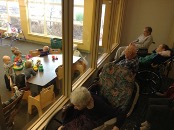
At Schowalter Villa in Hesston, KS, a viewing wall connects the nursing home to Hesston Community Child Care. There is a wheelchair ramp that goes into the childcare center.
“Even if older adults don’t participate in an activity, we find ways for them to appreciate the interaction through observation, posted art from the children, and photos of activities.”
— ONEgeneration
Activities can involve one-to-one pairings, small groups, and large groups. Think about the objectives of your activity and your physical space when deciding on the format. Usually, one-to-one or small groups are best for facilitating cross-age interaction and minimizing distractions.
Frequency of Interaction
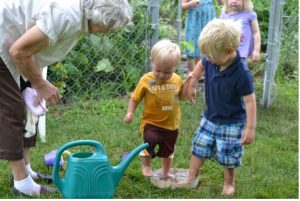
The more frequent and regular the interaction between children and older adults, the greater the likelihood of building meaningful relationships. Scheduling activities multiple times per week helps participants and staff become comfortable with each other and the physical space where the activities occur.
At Ebenezer Ridges, every day of the week, each classroom (infant through preschoolers) goes to a different part of the campus to interact with elders. Children and older adults often eat meals together and enjoy a variety of arts activities.
At Providence Mount St. Vincent, each classroom has six visits to elders every week. Activities are simple and usually increase the chances of touch between the two age groups. Examples include:
- Children distributing percussion instruments and scarves to increase participation in dancing
- Five-year-olds making sandwiches and decorating lunch bags with residents which are then taken by staff to a local homeless shelter
- Residents performing fables and children’s stories for the children
- Children and residents engaging in chair dancing with music from the 1930s and 1940s
Duration of Interaction
Depending on the age of the children and the functional level of older adults, activities will vary in duration. For young children, their attention span means activities should often last 20-30 minutes.
Number of Participants and Ratio
When possible, it is best to have a 1:1 ratio of children to older adults. If elders have dementia, it is best that the group of children remains small. At Mt. Kisco Child Care Center, participants are paired based on the functional abilities of the older adults (e.g. elders with strong communication skills are paired with preschoolers, those with language challenges are often placed with infants). It is important that program staff are present at all activities and able to facilitate interaction when needed.
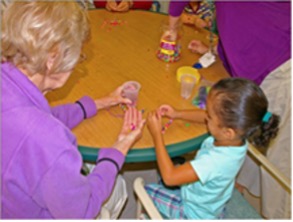
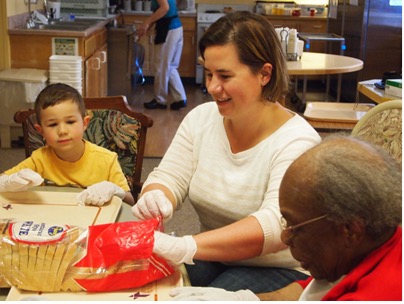
Scheduling
It can be difficult to find times for children and older adults to come together when you have to allow for naps, lunch and snack time, arrivals and departures of children and older adults, and other commitments that older adults may have. Mornings seem to work well in many shared sites.
Create a shared calendar of events for both child care and older adults. Try not to schedule intergenerational activities at the same time as other popular activities for older adults.
Example of a calendar from Jenks West Elementary/Grace Living.
Tips!
- Redirect a participant’s request for help from a staff member to an intergenerational partner.
- Alternate chairs of older adults and children around a table and angle the partners’ chairs slightly towards each other.
- Involve both children and older adults in preparing for an activity (e.g., distributing paintbrushes, setting out trays).
- Visit the program that you are partnering with to learn more about participants.
- If possible, have two facilitators – one presenting, and the other “floating” around the room to make sure no pair is neglected.
- Step back and let adult-child pairs work on their own as much as possible.
- Share information with families about the activities you are conducting. Some programs include information about their intergenerational activities in weekly newsletters or include it along with eating and health updates in daily reports that parents of young children receive.
- Enhance the perceived value of intergenerational programming by giving children stickers for participating. These also prompt parents to ask about the child’s experiences with older adults.
7.4 Engaging Participants
Engaging participants, particularly older adults, in intergenerational activities can be a challenge. While many older adults are comfortable interacting with children, some may feel self-conscious about their physical limitations and/or nervous about being around children. Others may resist sharing their “space” with children and prefer being with age peers. People with dementia may be afraid of being unsuccessful in an activity and feel unsure of unfamiliar terrain. It is important to involve people with varying levels of ability in your programming. By interacting with people who are incapacitated in some way, children will learn that disabilities do not define a person.
Participation by children often reflects their teacher’s level of enthusiasm about intergenerational programming. Some children, however, may need extra encouragement to interact with older adults. They may feel uncomfortable around wheelchairs and walkers, have fears about disability or death, or just feel shy when talking to strangers. Sensitizing children – along with their relatives and caregivers – to aging issues and facilitating intergenerational relationships can help children overcome their concerns and become actively engaged.
Effective Engagement Strategies
Develop targeted messages for different populations.
Reaching out to independent elders in a retirement community requires different strategies from engaging older adults who are nursing home residents or adult day care attendees. Think about:
- Who do you want to reach?
- What are their functional/cognitive abilities?
- What do they say about being with children?
- What messages would resonate with them?
Independent living: People who live independently may be involved in other activities within or outside of the retirement community and reluctant to make long-term commitments. Focusing on the benefits they will receive by helping children learn new skills might motivate some to join your program. You can also stress that interacting with children is an opportunity for them to share their skills and experiences. Here is a sample message:
You have so much knowledge and experience. Share it with the next generation. SHAPE THE FUTURE.
Methods to reach out to residents of retirement communities include:
- Meet with new residents and offer specific opportunities for them to get engaged on their own schedule (e.g., volunteering in classrooms, prepping meals, planning special events).
- Use your in-house newsletter and compelling photographs to highlight intergenerational activities.
- Create a short video highlighting testimonials from residents engaged in intergenerational activities.
- Ask a group of older adults to serve as peer recruiters or intergenerational ambassadors who help plan events and generate enthusiasm among residents.
- Offer residents a range of volunteer opportunities that vary in terms of focus and time commitment.
- Provide information on intergenerational activities in all marketing material.
- Invite potential older participants to visit and see firsthand how intergenerational work is actually carried out.
Long-term care and assisted living: Engaging residents of a long-term care facility or an adult day program is somewhat dependent on the enthusiasm and commitment of the staff. Once you have that, your task involves finding those older adults who would like to participate. Messages that seem to resonate are those that stress how much older adults are needed to teach social and/or academic skills to children. Being needed can be a strong motivator for older adults who often lack opportunities to serve in a helping role. Staff should let older adults know what an activity will entail and why they would enjoy it. Giving people the option of just observing or easing into an activity can promote engagement among those who are reluctant to “jump in.”
Tips!
- Think carefully about which older adults should be involved in an activity. Some activities will be more successful if older adults with varying levels of ability participate. This can provide opportunities for peer and intergenerational support.
- Remind people 5-15 minutes beforehand that an activity is coming up.
- Bring a small group of preschoolers into the adult program to work on puzzles. Older adults who are reluctant to participate often wander over and help the children complete the puzzles.
- Focus on older adults’ sense of purpose and try to align activities accordingly.
- Make sure that intergenerational activities don’t conflict but produce synergies with other activities already in place.
Engage older adults in planning and/or coordinating activities.
Involving older adults in the planning of activities can build a sense of ownership and increase participation. You might want to create programming themes and then ask participants to flesh them out. If some older adults have the relevant skills and experience, ask them to help lead an activity (e.g., painting, singing, reading).
Example: At Providence Mount St. Vincent, one of the residents who had previously lived and worked in the Grand Canyon collaborated with a preschool teacher to plan a theme around National Parks. The children enjoyed hearing her stories about living in wild places.
7.5 Preparing Older Adults to Work with Young Children
It is helpful to prepare older adults before engaging them in intergenerational activities. The amount of training you provide will depend on the role older adults are asked to play in your program. Invite staff members from the child care department or your partner agency to join you in presenting the training/orientation. These staff members can provide a clear picture of what to expect when interacting with the children.
Training will help participants:
- Understand the overall goals of the intergenerational program and how they can contribute
- Appreciate the strengths, challenges, and developmental tasks of the children with whom they will be working
- Express their hopes and concerns about working with children
- Develop specific skills that will enhance their effectiveness (e.g., teaching, reading, storytelling, and/or effective communication)
When training older adults, it is important to:
- Draw on their experiences as parents and grandparents
- Be sensitive to the literacy levels, sensory limitations, and cultural differences of participants
- Encourage them to ask questions
- Highlight how they can help children develop specific skills
- Model good listening skills
- Be flexible. Change direction if an activity isn’t working
- Help them to understand that intergenerational work is a fun, enjoyable activity
Sample Training Outline
Ice-breaker
- Think back to when you were a young child. What did you like to do? What made you happy? Did you interact with any older people on a regular basis?
- Think about when you were a parent, aunt, or uncle. What kinds of things did your children, nieces or nephews enjoy? What kinds of things did you do to make them happy?
Discuss responses in the large group.
Hopes and concerns about working with children
Brainstorm what participants hope to achieve or learn from their interaction with children as well as their concerns.
Topics to discuss:
- Child-care practices: It is important to discuss current child-care practices with older adults, stressing that these practices might be different from the ones they used when parenting. This will help older adults avoid being judgmental about how teachers handle challenging situations.
- Developmental differences: The children with whom the older adults will be working will vary in terms of their developmental levels. It is important to share basic child development information about the age groups involved in programming so that the older adults can have realistic expectations of the children.
- Effective ways to support children: Initially setting ground rules related to interacting with children will help avoid problems later. These rules might include not kissing on the mouth, not holding children too tightly, and/or not swearing. Ask older adults to brainstorm other ground rules they would like to add. It is also important to explore what roles older adults can play in helping children learn social and academic skills and the types of communication patterns that are helpful.
- Importance of relationships throughout the life-course: Explain that intergenerational work is but another opportunity to keep our relational nature alive.
Reflection
What did you learn today – about children, and/or about yourself?
What surprised you?
What else do you want to know about helping young children?
Tips!
- Offer a “practice” session beforehand to older adults who are not confident they can be successful. Tell them that they are practicing so they can teach the children how to do the activity.
- Invite older adults who have already been involved in intergenerational work to share their experiences with their peers.
- Be sensitive to residents who prefer “parallel play” rather than having a teaching role with kids.
- Provide older persons with opening routines if they feel uncertain about how initial interactions with children are going to evolve.
7.6 Sensitizing Young Children to Aging Issues and Older Adults
Depending on the age of the children in your program, you can do a number of things to prepare them to interact with older adults. Here are a few ideas:
Explore Perceptions of Aging
- Ask children “What do you think of when you hear the word ‘old’?” Then ask children to draw a picture of an older person they know. In a large group, talk about the difference between age-related stereotypes and real-life older people in their families.
- Ask children to close their eyes and try to imagine themselves as an older person. Guiding questions include:
- What do you look like?
- Where do you live?
- What are your favorite things to do?
- What makes you happy?
- Discuss concerns children may have about interacting with older people and help children understand that they, too, will be old someday.
- Invite children to identify older relatives, teachers, and neighbors and help them understand how different older people may be.
Read Books with Intergenerational Themes
Children’s books that dismiss ageism and portray loving and fun intergenerational relationships between children and a modern older adult, whether a grandparent or someone outside the family, are powerful in developing a child’s worldview of aging and longevity. At the same time, children need to learn about the realities of aging diseases and disabilities without connecting disease to ageism.
It’s challenging to strike that delicate balance when selecting children’s books. Most classic children’s picture books, and many modern books, reinforce unflattering, archaic stereotypes of older adults who are more nemesis than friend.
Here are a few different lists of books with intergenerational themes:
- Next Avenue’s List of Children’s Books that Get Aging Right
- The Linking Network’s Intergenerational Linking Booklist
- The Growing Up and Growing Older: Books for Young Readers© booklist: a compilation of carefully selected children’s literature.
- A curated list of Positive Aging picture books
- Generations United’s intergenerational themed booklist
- The Alzheimer’s Association booklist and resources for kids to learn about Alzheimer’s disease
Clarify Guidelines for Interaction
Discuss with children how to start a conversation with an older adult or how to gently approach an older person. At the Grace Living Center in Jenks, OK, teachers and children make a chart that highlights appropriate behaviors when visiting with their “grandmas” and “grandpas.”
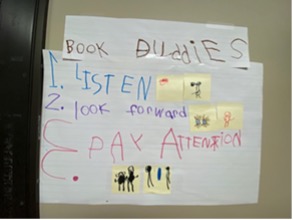
Teachers pose questions to help children think about how to interact with older adults.
These include:
- How do we start a conversation with one of the grands?
- What are kind words we might use?
- What questions might we ask?
At Providence Mount St. Vincent, messages given to children include:
- “Don’t run through the halls because we may run into a resident and someone might be hurt.”
- “This is the residents’ home and we need to respect their things.”
Other questions you can ask children include:
- What does it mean if an older person waves at you but doesn’t say anything?
- How will you know if an older person is worried about something?
- How will you know when an older person is happy?
Expose Children to Equipment
Introducing children to wheelchairs, walkers, oxygen tanks, and other assistive devices can help sensitize them to disability issues and minimize their fears. You can bring some of this equipment into the child-care center or provide opportunities for children to interact with older adults who are using assistive devices. It is important to share guidelines related to the use of equipment with children (e.g., rules about pushing wheelchairs, sitting on walkers).
Explore Ways to Greet Older Adults
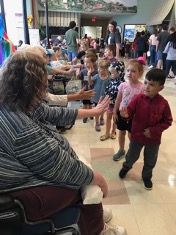
It’s helpful to talk to children about how to address older adults. In some shared sites, older people are called “grandma” and “grandpa,” while in others elders are called “friends,” “grands,” or Miss/Mr. (first name). It is important to understand cultural differences when deciding how to address older adults. Having a consistent greeting is another way to facilitate interaction. At some shared sites, children sing a special song (e.g., “hello neighbor”) when they greet the older adults and shake everyone’s hand when they leave.
How children and elders greet each other reflects the nature of their interaction. When they spontaneously greet each other, it shows a degree of comfort and familiarity with each other.
Be a Role Model
Teachers and facilitators should model how to interact with older adults. If children see teachers feeling comfortable shaking hands and conversing, they, too, will feel more comfortable.
Tips!
- Be sensitive to the time of day you schedule activities and to the noise level.
- Facilitate participation by making appropriate accommodations such as using raised flower beds or tables that are the right height for wheelchairs.
- Be aware that people with visual impairments or other sensory issues may be overwhelmed by music playing or brightly-colored wall art in toddler classrooms.
- Make sure the environment is free of tripping hazards and easily navigated with a walker or wheelchair. It is best if the children don’t move quickly through the room.
- Place a few toys on the older adult side and have booster seats available to ensure children can reach the tables to do an activity.
- Allow for unexpected engagement to arise, even if it means that an already planned activity won’t reach its anticipated objectives.
- If possible, and especially in the beginning, have children and older adults working in pairs or small groups so that it is easier for them to get to know each other and feel comfortable.
7.7 Fostering Informal Intergenerational Interaction
Bringing children and older adults together for their mutual benefit is a process not simply an activity or program. In addition to structured activities, creating opportunities for informal encounters will increase the likelihood that meaningful cross-age relationships will develop. This organic vs. planned approach helps participants grow to know each other naturally out of curiosity and common interests. Elders are encouraged to engage in familial-like caring behaviors. Although this may mean that older adults are drawn to certain children rather than giving equal attention to everyone, it is important to let these connections happen naturally.
Create a home-like environment.
At Kotoen, a shared site in Tokyo, older people help with a variety of family-like activities such as dressing and undressing children at nap time.
Build contact into the daily schedule.
You can foster informal encounters by having older adults outside while the children are engaged in their daily walks or by encouraging child-care staff to drop by the older adult program.
Take advantage of teachable moments.
Natural interactions can lead to questions about aging, death, and disability. It is important to encourage children to pursue sensitive inquiries with staff and older adults.
Schedule meals and snacks together.
Children and older adults often eat breakfast together at Mt. Kisco Child Care Center. At Benevilla, lunchtime is a great opportunity to chat about the day’s events.
Use age-appropriate furniture.
Adult and child furniture should be available in all program areas so participants can just drop by for visits with each other.
Create intergenerational contact zones.
Design nooks and crannies throughout your facility to help older adults and children sit together when they meet outside of a scheduled activity. These contact zones are spots that invite people to interact and often have comfortable couches and chairs.
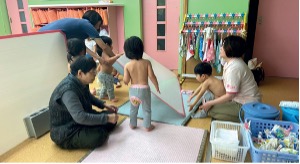
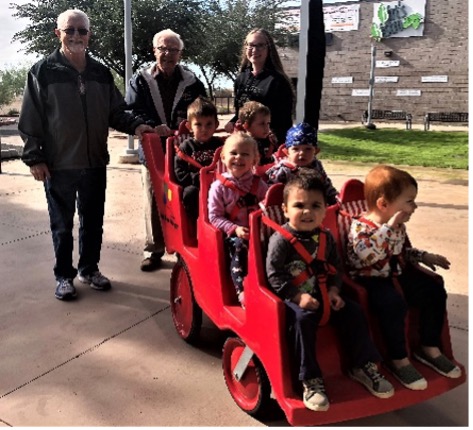
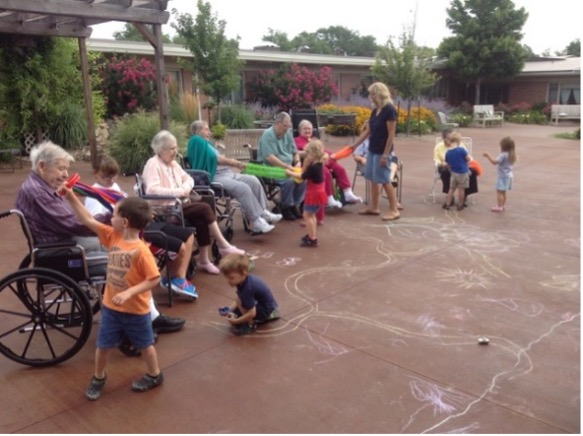
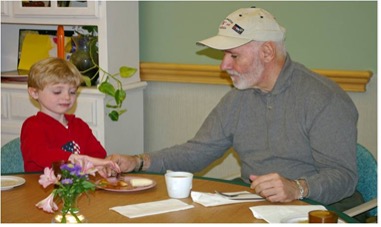
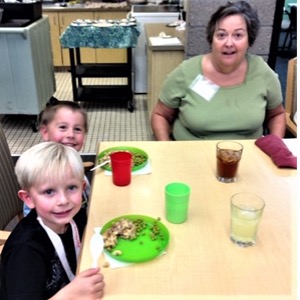
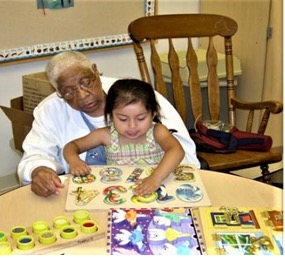
Previous
Next
Tips!
- Encourage older adults to attend “celebration of learning” ceremonies and participate in ushering, guest speaking, bestowing diplomas, and cheering. These are great opportunities for children to share thank-you cards and express their appreciation to older adults for the time they have had together.
- Think about ways that one generation can support the achievements of another age group’s goals without necessarily requiring intergenerational contact (e.g., helping teachers with specific tasks, making cards for homebound older adults).
7.8 Engaging Family Members and Community Volunteers
Why recruit volunteers to be part of your intergenerational site? Volunteers of all ages can:
- Help build your capacity to plan and implement innovative intergenerational programming
- Expand the number and type of activities that are offered to your participants
- Bring additional expertise and resources to your site
- Spread the word about the great work you are doing
Families
Think about ways you can engage family members in activities. They may be able to help you plan special events such as spring/fall festivals, book fairs, book character dress-up days, or a fun field trip. Participating in these events can give family members a better understanding of the value of intergenerational relationships and a greater appreciation of the uniqueness of your shared site. Having additional helpers during activities can also increase the level of interaction between children and older adults.
School-Aged Children
Many shared sites develop partnerships with elementary, middle, and high schools. School-aged children can engage in a wide range of activities, such as oral history, creative arts, health promotion, gardening, and technology. Bringing another population of young people into your shared site will expand the continuum of intergenerational opportunities available to both older adults and young children. These partnerships can also increase your visibility in the community, ultimately impacting your marketing and fundraising efforts.
EXAMPLE: Grace Living and Jenks West Elementary, Jenks OK — Poem by a student
People are people no matter what age
From young to old, we’re all the same.
Over the years the younger generations have changed….
From crew cuts to long hair to colored punk.
But as we mature, we learn by mistakes,
Grow lots of trust, Work together to make thing better.
It takes a bit of everyone from past to present
to help the next generations learn from our mistakes.
Work together, listen, trust, share!
That’s what we honor in Moments from Grace!
College Students
Engaging students from local colleges and universities in your shared site can also enhance your overall programming. Departments focused on health, social services, and education are often looking for field placement and/or internship sites. Building relationships with faculty in relevant departments can result in an ongoing source of student volunteers. Many colleges and universities also have vibrant service-learning programs. Students from a variety of fields might be interested in helping you develop or facilitate innovative intergenerational programs. Think about how students majoring in art, music, or dance could enhance your activities. Imagine English majors conducting book clubs, political science students facilitating discussions on current events, and/or anthropology students teaching English to immigrant elders and children. The possibilities are endless!
Too often, college students work only with one age group, thus missing the opportunity to learn about development over a lifespan and the value of intergenerational connections. Make sure to engage students in a variety of activities involving both children and older adults.
EXAMPLE: ONEgeneration, Van Nuys, CA
All programs from ONEgeneration are supported by a strong volunteer core. High-school students tutor elders one-on-one on the computer, internet navigation, and email. College interns in Gerontology, Social Welfare, Public Health, Nursing, and many other fields of study volunteer each semester for course credit. These students work directly with seniors with cognitive impairments, complete assessments during home visits, work with young children, and much more.
Older Adult Volunteers
You may also want to reach out to older people who are living independently in your community. Some may be looking for opportunities to use their skills and experiences to help others. You can partner with a Retired Senior Volunteer Program (RSVP), older adult clubs, religious institutions, and/or civic organizations to recruit people who are seeking meaningful volunteer experiences.
Tips!
- Hire a volunteer coordinator to manage your partnerships and support your volunteers. If this is not financially feasible, try to find either a retiree or college student who would be willing to volunteer in this role.
- Be flexible. Build on the strengths and interests of volunteers rather than trying to fit everyone into a preconceived volunteer role.
- Provide orientation and training to all volunteers before they interact with your participants. Clarify your expectations.
- Create opportunities for volunteers to give you feedback about their experiences.



